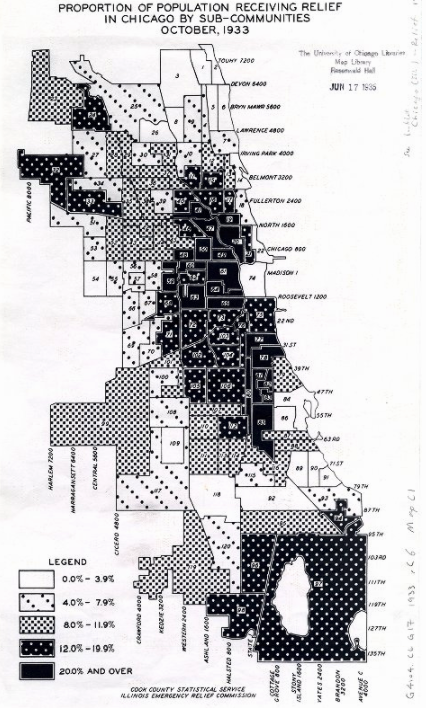Subsidizing sewers in the suburbs
In a bit of a prelude to a bigger project I’m working on, I was looking at 80-year-old sewer maps. Thank you, University of Chicago, for digitizing a 1931 map of Chicago Sanitary District expansions.
A fun thing is looking at this map side-by-side with the “Proportion of population receiving relief in Chicago by sub-communities” map from 1933. There, darker = greater percentage of people on relief.
The near west suburbs and north shore are getting linked up to Chicago water. Wilmette put out a bond measure to get its own pumping station in 1931. Oak Park, meanwhile, had gone from 19,000 people in 1910 to nearly 40,000 in 1920 — up to 64,000 by 1930. These areas were booming, so in a way it makes sense that Chicago wanted to make sure that fresh water went in and waste water went out of these bedroom communities.
Down south was something entirely different. There were plans to connect Oak Forest to the city of Chicago’s water supply. Which is nice, because at this point in time Oak Forest was basically just a “poor farm,” or housing for the indigent. “For the ‘deserving’ paupers,” as an asylum wiki website puts it.
(The area of that former asylum is now the Oak Forest Heritage Preserve. Complete with master plan, which certainly sounds like something.)
Again, from the 21st-century perspective these all sort of seem logical: Chicago literally has the Great Lakes right there, and they may as well send water to the people who are working in Chicago but living a bit outside of it.
But on the other hand: why is Chicago helping out the folks who are fleeing Chicago? The logic at the time might have been that the city needed these rate-payers in order to help balance out the people on relief in the city, but surely there were other ideas that didn’t involve huge capital outlay. Jane Addams and Ellen Gates Starr were still alive, after all.
I don’t have access (yet) to the historical documents here, but I’m dying to know: how did people discuss Chicago utilities being used to support wealthy people leaving Chicago?
Fast-forwarding to today: how much are suburban home values buoyed by the infrastructural support that core urban areas provide? Highways are the most popular example, but there’s a whole host of other commodities (water! healthcare! labor!) that follow a similar path, in a similar historical timeframe. They should be part of the same popular conversation as transit and housing are now, part of the whole pop urbanism online thing and the city council angry local thing, no?



